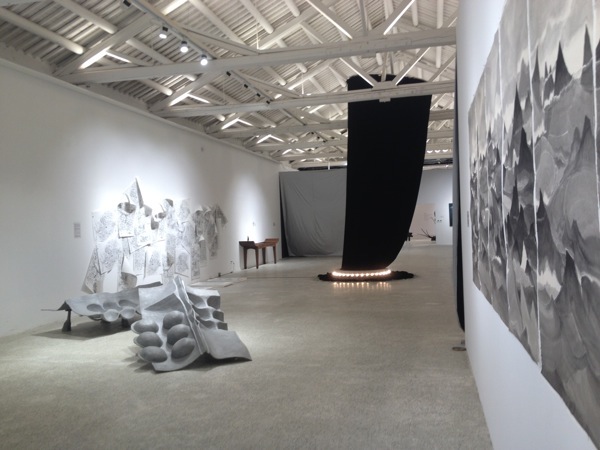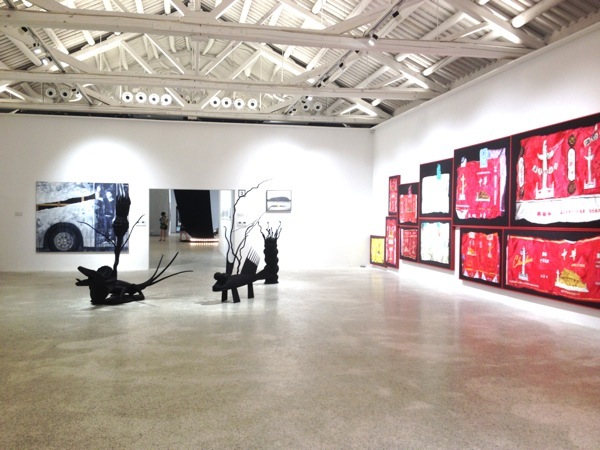The T-Museum, just south of junction of the Grand Canal and the Qiantangjiang River in the West Lake Scenic Area, certainly boasts amazing fengshui. That should keep the stream of riches flowing its way, but whether it will be blessed with critical auspiciousness is another question entirely.
Still, it does make a modest contribution to the cultural landscape of Hangzhou—a city which has very little in the way of contemporary art venues (despite the many artists who lingered after graduating from the China Academy of Art). The unique locomotive-themed park with train-car cafes, cranes and even a functioning mini-choo-choo for the critters, T-Museum is an art-park with a populist twist. On the sweltering July afternoon when we visited, this far-flung venue with newly planted grass and saplings struggling to survive was teeming with visitors—which is more than one can say for other museums scattered throughout the outer reaches of the Yangtze delta (not to point the finger, but Sifang and True Colors are two examples).
Baita Park, sardonically described by my companion as “huoche-tiandi” (“train paradise”) was originally built as a train station in 1907 and used to transport goods into the city of Hangzhou until the Cultural Revolution, when its main cargo became people. At this point, the station became a collection point for rusticated youth “sent down” to the countryside to “learn from the peasants”.
Shen Qibin (沈其斌), the mastermind of the project, has a rather interesting resume and identity. For one, he seems unabashed about mentioning “academic research” and “art investment” in the same sentence. Formerly the head of the Duolun MoMA, Zendai MoMA and the Himalayas Museum, a distinguished lecturer at CAFA Art Management and Investment and a member of the Cultural Bureau Policy Research Institute, Shen Qibin has long been involved in the world of curating and/or art investment. The self-described “art capital incubator” first headed up the T Museum in 2011 when it was located on the 14th floor of a Times Mansion in the slightly empty Qiangjiang River New Town, where he held exhibitions for Jin Feng, Can Xin and Qiu Zhijie. Shen has recently been making big waves in the art market by encouraging the nouveaux riches of Hangzhou to dig deep into their purses for such cutting-edge artists as Xu Zhen.
The museum’s main backer is the Zhejiang Tianren Arts and Culture Company, which had a booth this year at the Armory show. According to the Hangzhou Daily, the art financial management company collaborates with Poly Auction and has a private equity art fund which was valued at over 105 million RMB in 2013. The fund features mostly late-career artists possessing art historical value and unique artistic language, whose works have not been subject to strong speculation and are thus relatively modestly priced. Given this background, one might suspect that T Museum falls more into the category of a private gallery, one which holds museum-scale shows and has other museum-like functions; but then again, the line between museum and gallery in China has never been terribly clear.
The curator Zhao Jingyan (赵婧妍), a recent graduate from China Art Academy multimedia department, explained to us that the museum is also applying for government funding and that they received a ten-year lease on the land from the Hangzhou government, along with a number of preferential policies aimed at promoting the arts.
In terms of the direction of the museum, Zhao points to international exchange and academic research: “In the future, we hope to spark a new voice or perspective, a new academic direction. This is a core motivation of the T-Museum. We hope to see a more pluralistic artistic spirit and academic thought within the museum, so that it can become a crossroads for theoretical research and academic interests.” In terms of exchange, T-Museum plans an international curatorial residency where curators will be invited for a month’s stay which, according to Zhao, “will allow them the opportunity to have close contact with artists and build an understanding about the current state of local creativity and living artists. The main purpose is to enhance international understanding of the Chinese contemporary art ecology.” One might wonder if it is also an opportunity for foreign curators to “big up” the artists in the art fund, but such cynicism is perhaps uncharitable. The museum also features artist residency programs. The first of these began in August with artists He Jie and Luo Xiaodong. The museum will use a number of long exhibition halls to host exhibitions of various sizes, supporting younger and more established artists with up to 20 shows a year.
The opening show “Fusion•Conversion”, which attracted a number of government bigwigs and other names in art such as Li Xianting and Qiu Zhijie, was more like a series of solo shows with little curatorial cohesion and poor presentation, with wires straying from behind television screens and artworks placed on plinths which were clearly too small. There were also some terrible eyesores (think giant golden bull sculpture perched atop ceramic statues of dogs) which stuck out like a badly disguised “art spy” at a posh vernissage.
That said, there were a number of strong pieces and some prominent names—Shen Qibin has the guanxi to pull in strong artists, even if his curatorial credentials may not be entirely solid. Though the programming may be weak at the moment, there is very little competition in Hangzhou, and the strength of the space and its unique historical character, along with the potential for interesting solo shows with Shen’s stable of artists, mean that there is hope for T Museum. That is, if its plans are not derailed by shadowy market interests.







